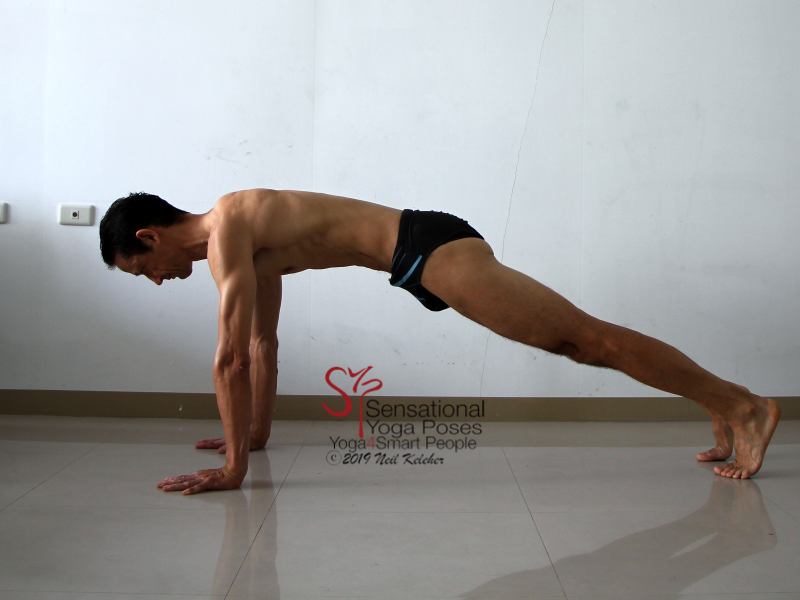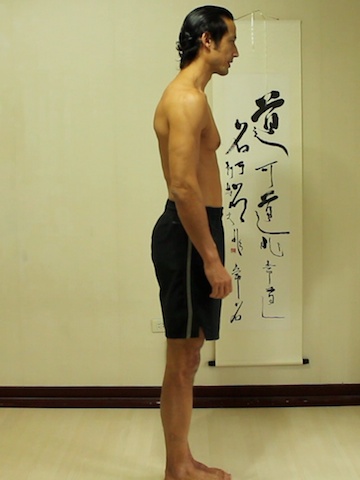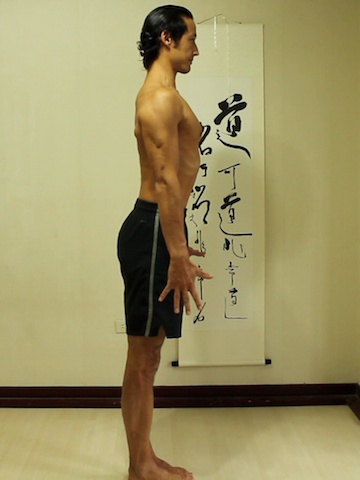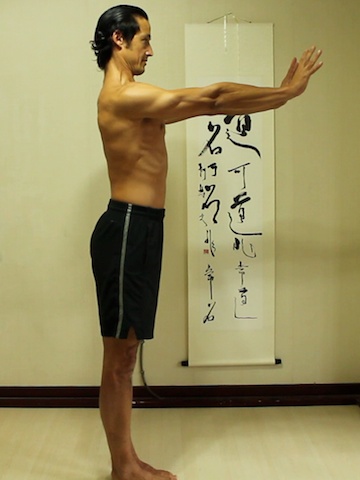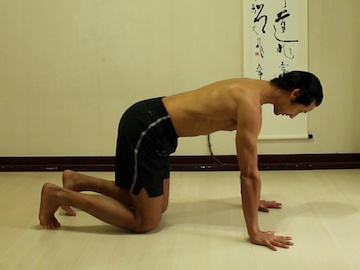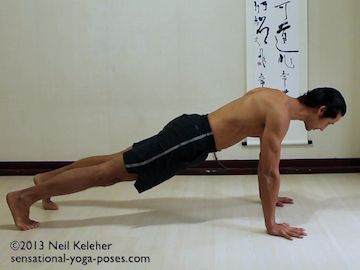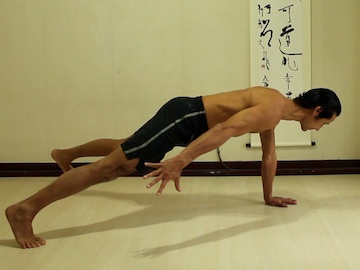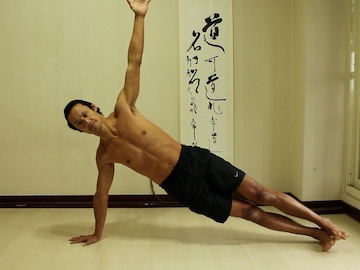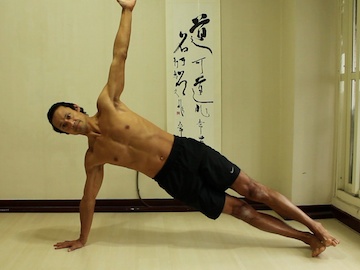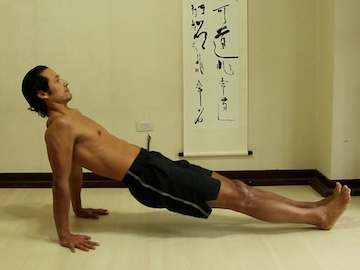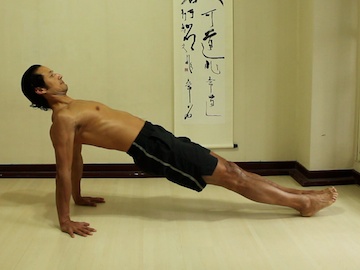Try breathing like that!
Now have you ever held a snake. (No boys, not the trouser snake!) Or even seen one? If you pick them up they are still mobile but all the parts of the snake are all connected. No one part wobbles. The whole thing is connected, strong and mobile. That is more like what you are trying to approach with core stability exercises.
Create strength, mobility and control.
Essentials of Creating a Stable Core
These core stability exercises could be considered the core or the basics for a more developed core stability exercises. They are the basic actions that you need to be able to do while doing anything else, and that includes yoga poses but can also include lifting weights.
Part of these exercises include developing control of your core. But what they are really about is creating tension and space.
Focus On a Feeling of Length
The essence of creating core stability is making your body "feel long". That means making the parts of your body feel long including your spine, legs, arms, and even your fingers, hands, toes and feet. Make these parts of your body feel long.
Why focus on the feeling of length?
If your fingers are bent, you use the muscles of your hand to straighten them. If you are putting on a pair of kitchen gloves, you keep your fingers straight and strong in order to pull the glove on without your fingers bending. Even though you can only straighten them so much, the more long you make your fingers feel the more tension you add to your fingers.
What makes your fingers feel long (or what gives us the feedback or impression that we are making our fingers feel long)? The tension you create. Initially while fingers are bent the tension that you add straightens them. But to make them feel "more straight" you add even more tension.
Even though you don't straighten our fingers any more,you can make them "feel" straighter by adding more and more tension. The feeling is like you are trying to poke the bones of your hands through your flesh or like you are pulling the flesh back over our bones.
You can do the same thing with your spine. You can make it feel long by pulling your head back and up, away from your ribcage. this makes your neck feel long and also adds tension to the connective tissue of the neck. Meanwhile you can tension to your ribcage by lifting and expanding the ribs (front sides and back.) This not only adds tension to the connective tissue between the ribs but also to that between the ribcage and the pelvis.
Using Tension to Stabilize Pockets of Muscle
Why is tension important? On one hand it helps to stabilize the head, ribcage and pelvis relative to each other. But this tension also serves as a foundation for our muscles.
Muscles are embedded within "pockets" of connective tissue. Muscles act via connective tissue to position (or stabilize) bones relative to each other.
However, they also add tension to this connective tissue and can be affected by the tension in this connective tissue.
Muscle tend to be linked by anatomy trains, (Thomas Myers' name for lines of connective tissue throughout the body that connect separate muscles.
By contracting one or more muscles in a single train not only do you affect the bones that those muscles act on your tighten the anatomy train (or trains) that they are a part of. Other muscles in that train then have a stable foundation from which to either contract or relax.
Ideally what this means is that you have muscles (and via them bones and joints) that are more controllable.
Core stability exercises (via connective tissue tensioning) can help you develop better control of not just your core, but your whole body. Or if you like, you can think of your connective tissue network as your "core." Being able to control this network, via tension and space, you can improve your control over your body.
And it can arise from training yourself in the art of making your the parts of your body feel long.
Core Stability Exercises
The core stability exercises below are very simple. In all of these yoga poses the legs and torso form one straight line that is supported by one or both arms while straight. However before doing these core stability exercises you can practice making your body feel long while standing. This can actually be the first exercise.
The first preparatory exercise involves making your spine feel long while sitting. (I'd suggest do it first while sitting so that you can focus on reaching your ribs away from your pelvis.
Then learn how to create space in your hip joints.
Then do both of these actions while standing. The goal (at this stage) isn't to hold the tension but rather to breathe into it.
Inhale make your legs and spine feel long (your arms as well, then can reach down.) Exhale and relax. While standing you can create space in your hip joints by pushing your knees down, away from your hip joints. It can feel like you are "drilling" your legs into the floor. At the same time lengthen your spine out of your pelvis. In both cases as you inhale make your legs and spine feel long (arms as well.) Exhale and relax. To get ready for plank, reach your hands forwards and make your arms and fingers also feel long as you inhale.
In the first picture I'm standing relaxed, head forward, chest down. In the second picture I'm making spine and legs long (notice my head is pulled back and chest is lifted.) In the third picture I'm also making my arms long.
A slightly more advanced technique based on an understanding of the deep front line anatomy train involves moving the lower back ribs (or back of the kidneys) away from the pelvis.
The feeling can be like you are "expanding" the backs of your kidneys.
At the same time you can focus on squeezing the top of your inner thighs. For this action you can push your thigh bones out a little (to resist the inward pull) and then work at activating the top of your inner thighs.
Protect Your Wrists
All of these core stability exercises involve using your hands to support part of your body weight. So that your wrists remain strong, focus on pressing your finger tips into the floor. This action will add tension to the tendons (and ligaments) that cross your wrists. It also helps to add tension to the myofascial meridians that run up the front and back fo the arms.
Plank Pose
In the second picture I'm "relaxed". In the third picture I'm focusing on being long. In the fourth picture I'm even more focused on length and creating extra tension to make this core stability pose stable.
Once you can make your body feel long while standing try the same feeling in plank pose with your arms straight.
You can start from cat pose. First practice pressing your finger tips into the floor.
Then Use your shoulders to push your ribcage upwards. Make your arms feel long. Then to make your spine feel long pull your head up so that is horizontally in line with the spine, and forwards. Pull chin to chest to emphasize the lengthening of your cervical spine. At the same time reach your chest forwards, away from your pelvis. But keep your pelvis in the same place. Relax while you exhale.
Then do the same thing with your legs straight. Straighten them one at a time after first making your spine and arms feel long. You can either return to cat pose as you exhale or relax your "length" as you exhale.
Note that if your pelvis sags a little you may have to add some tension to you abs. However, with your ribs lifted and your waist long, you may find that this is easier to do. If you do have to tense your abs continue to keep your ribs open and your waist long.
Quite often I get students who push their pelvis to high or let it sink down while doing plank. They aren't used to feeling their body.
To get used to the feel of your body try this. Stand and with your pelvis forwards so that your legs reach forwards and your spine back. Make your legs and spine feel long. Then do the same thing but this time with your pelvis back.
There is a distinct difference in the feeling in these two poses compared to when the body is straight. Try the same thing in plank, make your body long with pelvis high, and then with your pelvis sinking down. And then notice the difference in feeling when your heels, pelvis, and spine are all in one line.
For a real test of core stability, spread your feet slightly and slowly take one hand off of the floor without moving the rest of your body. Practice lifting your hand slowly. Actually, relax it first and then lift it. As you relax you'll have to "tighten up" in order to maintain body position. But focus on keeping your body long and open as you do so.
Side Plank Yoga Pose
As with all the other core stability exercises, exhale relax, inhale and make your body "feel" long.
When doing side plank pose as a core stability exercise, you can focus on aligning your legs and spine.
Make your fingers long and press them into the floor. Use your shoulder to push your ribcage away from the floor. Make your feet long and strong too. Then focus on making your spine and legs feel long.
Muscles will engage but rather than just engaging them you are engaging them with the purpose of making your body feel long. This is what creates stability and it does so by adding tension to your connective tissue network.
So that this pose is truly long, reach your top arm up also. Spread those fingers.
Inhale and make your body feel long, exhale and relax a little.
Note that if you aren't used to using your legs to lift your pelvis, try this with knees bent first. First press your finger tips into the floor to add tension to your fingers and wrist. Use your shoulder to lift your ribcage up. Then press your knee into the floor using your outer thigh so that your pelvis lifts up. Once you can do this exercise with knees bent, then try it with knees straight. Look for the same feeling, use your outer thigh to lift your pelvis.
Reverse Plank
In reverse plank (purvotanasana) the usual version of this pose (especially in ashtanga circles) is to touch the fronts of your feet to the floor. For this core stability exercise, just press your heels down.
As with the other core stability exercises, press your finger tips into the floor. Spread your fingers also.
Make your arms and legs long and push your heels into the floor to lift your pelvis.
If you have your hands in front of your shoulders or beneath them, try frictioning your hands forwards to help pull your shoulders back. Make your shoulders feel even more open by pushing your ribcage up.
You can also experiment with having your hands slightly behind your shoulders. Press your fingers tips into the floor and use your arms to push your ribcage forwards and up. But continue to make your spine and legs long.
Make Your Body Feel Long
The main lesson in all of these core stabilization exercises is to lengthen your body. Create space to add tension to the connective tissue network of your body. Relax to dissipate the tension.
The interesting thing about adding tension to your connective tissue network is that it makes both strength training and stretching easier. And so core stability exercises can be more than just "strengthening your core." They can be about developing control and range of motion of your body.
Published: 2012 02 08
Updated: 2021 02 10
